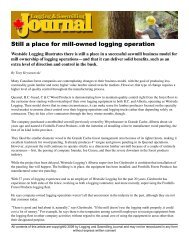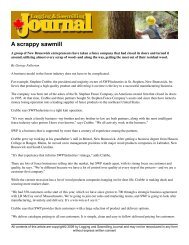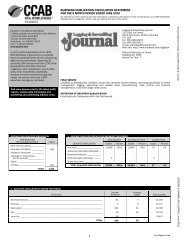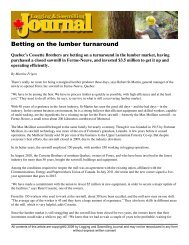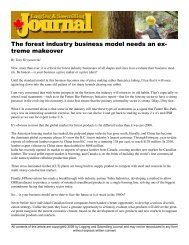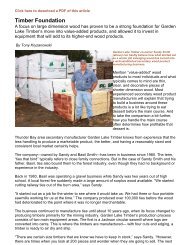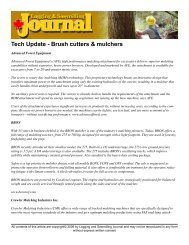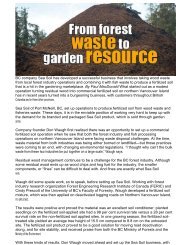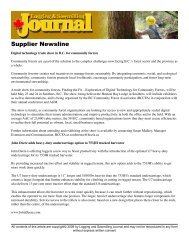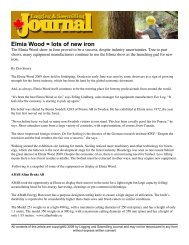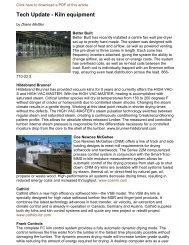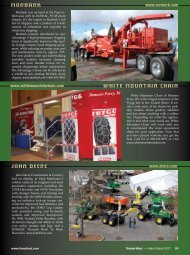Solid biomass business case.pdf - ForestNet
Solid biomass business case.pdf - ForestNet
Solid biomass business case.pdf - ForestNet
Create successful ePaper yourself
Turn your PDF publications into a flip-book with our unique Google optimized e-Paper software.
<strong>Solid</strong> <strong>biomass</strong> <strong>business</strong> <strong>case</strong><br />
An Alberta power plant is proving that there is a solid <strong>business</strong> <strong>case</strong> for <strong>biomass</strong>-based<br />
power, and it has attracted international investment attention.<br />
What’s a power plant that burns residual wood fibre to produce electricity doing in the middle of Alberta farmland?<br />
Well, the plant wasn’t always there and it didn’t always use wood fibre—but it does now and it has attracted attention<br />
from investors from as far away as New York.<br />
In 2007, White Plains, New York-based, Fortistar acquired full ownership of Dapp Power, located about 130 kilometres<br />
north of Edmonton, with its purchase of Calgary-based Verdant Energy. It also acquired 50 per cent ownership in Valley<br />
Power in Drayton Valley, Alberta, which also uses woody <strong>biomass</strong> as its fuel.<br />
The purchase of Verdant Energy added the Alberta power plants to Fortistar’s considerable North American alternative<br />
energy portfolio, which consists of power generated from 60 projects fueled by methane gas captured from landfills, three<br />
natural gas fired co-generation projects, and a large greenhouse division that produces about six million pounds of<br />
tomatoes per year.<br />
Founded in 1974 as an affiliate of one of the world’s largest insurance companies and headquartered in the United<br />
Kingdom, Fortistar began investing in the independent power industry in 1986. Since then, it has invested about $600<br />
million in 25 separate deals to grow its portfolio, including the two woody <strong>biomass</strong>-based power plants in Alberta.<br />
“Fortistar has a much broader base of operations and a much bigger balance sheet as a parent company,” says Grant Noll,<br />
the company’s vice-president of operations for Canadian assets, who was formerly with Verdant Energy. “So they have<br />
better access to capital for investment and growth opportunities.”<br />
Noll says that Fortistar is definitely shopping for new projects, although their main focus lately has been to streamline<br />
operations in Alberta and on opportunities in the U.S. The company has not spent much time investigating the potential<br />
use of mountain pine beetle-killed wood in the B.C. Interior for power generation. Noll says two reasons for not taking a<br />
serious look at opportunities that may exist in B.C. is the high cost of wood delivery and the uncertainty revolving around<br />
long term fuel supply once the beetle wood resource is exhausted. Since woody <strong>biomass</strong>-based power plants are long term<br />
investments, the issue of secure long term supply is a major consideration.<br />
Dapp Power consumes about 180,000 green metric tonnes of wood residuals each year to generate 115,000 megawatt<br />
hours of electricity annually or about 16.5 megawatts per hour, which it sells under contract and on the Alberta Power<br />
Pool.<br />
About 70 per cent of its fuel is green woody fibre residuals consisting primarily of bark acquired from West Fraser<br />
Timber’s operations in Slave Lake, Alberta. It takes nearly all the wood residuals generated by West Fraser’s plywood<br />
plant and pulp mill. The remaining 30 per cent of fuel is clean wood salvaged from a landfill in West Edmonton, operated<br />
by another subsidiary, Bio Fuels Inc, as well as clean wood salvaged from other landfills located in the Edmonton area.<br />
All contents of this article are copyright© 2009 by Logging and Sawmilling Journal and may not be rerpoduced in any form<br />
without express written consent
The Dapp Power story begins long before its recent acquisition by Fortistar. The plant sat mothballed in California in the<br />
1990s after the forest wood supply there dwindled. Later, the power contract was bought out by the utility, and an Alberta<br />
project developer dismantled and transported the power plant to the Dapp location in 1998. The intent was to burn the<br />
area’s abundant peat moss in the power plant’s circulating fluidized bed boiler to generate power and sell it on Alberta’s<br />
power grid. However, that also failed after 15 months and the plant was mothballed yet again.<br />
“There were two key problems with the project,” says Noll. “One was that the peat fuel was very low grade fuel and<br />
secondly, the boiler that was associated with the plant when it was moved from California was really not suited for low<br />
grade fuels.”<br />
In 2004, after sitting idle for about five years, the Dapp power plant was acquired by Verdant Energy. Financing was<br />
acquired to modify and re-commission the plant, as well as refuel it on wood waste. The boiler was also converted from a<br />
rather unreliable, first generation, circulating fluidized bed boiler to a bubbling fluidized bed boiler, which Noll says<br />
classifies it as an updraft gasifier based on the technology that the company has installed at the plant.<br />
Because the plant was originally designed to burn wood fibre, modifying the material handling and conveyance system<br />
wasn’t a major issue. The challenge was developing a system where the plant could accept both forestry wood waste<br />
mixed with wood waste from landfills.<br />
The current version of the power plant was commissioned in January, 2006, and it has been generating power ever since—<br />
the only major change being the acquisition of Verdant Energy and its assets by Fortistar in 2008.<br />
Dapp Power receives about 30 truckloads of woody <strong>biomass</strong> from both Slave Lake and the Edmonton landfill location<br />
every day, delivered in 53 foot walking floor trailers. The waste wood from the landfill is primarily construction waste,<br />
and because the power plant only accepts clean wood waste, it must be manually sorted to exclude treated wood and other<br />
non-wood contaminants.<br />
Another main concern related to the <strong>biomass</strong> fuel acquired from both the forestry and landfill sources is metal and gravel<br />
mixed in with the wood fibre. Dapp Power has four magnets located on its processing line to capture any stray metal.<br />
“Handling the landfill diverted wood is a little harder because of metal mixed in with the wood, like nails in wood pallets,<br />
and it requires a little more manual labor,” says Dapp Power plant manager, Fred Stock. “But with the forestry waste,<br />
normally you can process it using an unmanned hog.”<br />
Since the moisture content varies widely between the landfill diverted wood and the forest residuals, Dapp Power blends<br />
the wood fibre in a 70/30 mix, attempting to achieve about 30 per cent moisture content in the fuel conveyed to the burner.<br />
The forest residuals are typically in the 40 to 50 per cent moisture content range, while the landfill material is usually in<br />
the 18 to 30 per cent range.<br />
The material is pre-processed at both the landfill and forestry operations, and is sized to six inches or less. When it arrives<br />
at the power plant, it is processed again through a custom built stationary hog—that Dapp Power manufactured—down to<br />
three inches or less and is stored separately in windrows in summer to encourage more drying, particularly with the<br />
forestry residuals. A two month supply of material is stored in the yard, and is typically only held for a maximum of about<br />
All contents of this article are copyright© 2009 by Logging and Sawmilling Journal and may not be rerpoduced in any form<br />
without express written consent
three months before it is used.<br />
“In the winter, the forestry material is stored in one large pile so that we can actually get it to heat up because of the<br />
pressure built up in it,” says Stock. “It definitely helps our winter operation.”<br />
The power plant uses a John Deere 724J front end loader to mix the material to achieve the 70/30 blend, controlled by the<br />
number of buckets taken from each windrow to the conveyor leading into the burner.<br />
The bubbling fluidized bed boiler operates differently from typical grate-type boilers, where, according to Stock, the fuel<br />
is deposited onto a grate which is inside a furnace “and burned like a campfire”.<br />
The bubbling fluidized bed boiler has a sand bed that is heated to about 1750 degrees Fahrenheit. The woody <strong>biomass</strong> is<br />
fed on to the sand and is gasified and burned as fuel to heat water in a boiler to create steam. The steam is pressurized to<br />
about 1300 psi at 950 degrees Fahrenheit. It is driven through a power generating turbine, which produces the electricity,<br />
and then the steam is cooled in a condenser and recycled. The power plant loses some water to evaporation, but uses only<br />
a small amount of water taken from two wells.<br />
Noll says there are pros and cons to marketing power in Alberta. The biggest attraction is that it has a deregulated power<br />
industry and open access to the transmission system. It also has a compliance market for carbon, meaning there is a<br />
market for carbon dioxide offsets tied into reduction targets and penalties for those who do not reduce their greenhouse<br />
gas emissions, which he says is unique in North America. Government funding sources also exist for biofuel type projects.<br />
On the flip side, acquiring financing for these projects can be difficult because they are long term investments and capital<br />
intensive, in an environment where there are few long term power purchase contracts in the range of 20 years available.<br />
Current contracts are in the five year range, which Noll says is a short time horizon for project developers. Biomass is also<br />
a relatively small player in the power generation industry.<br />
However, Noll believes that prospects for further development of <strong>biomass</strong>-based power generation in Alberta are good<br />
because there is a significant untapped <strong>biomass</strong> resource available. The attractive aspect to power generation using<br />
forestry <strong>biomass</strong> is that it is a base load type of power that is available 24/7, as compared to wind and solar power<br />
generation, which are intermittent.<br />
All contents of this article are copyright© 2009 by Logging and Sawmilling Journal and may not be rerpoduced in any form<br />
without express written consent



